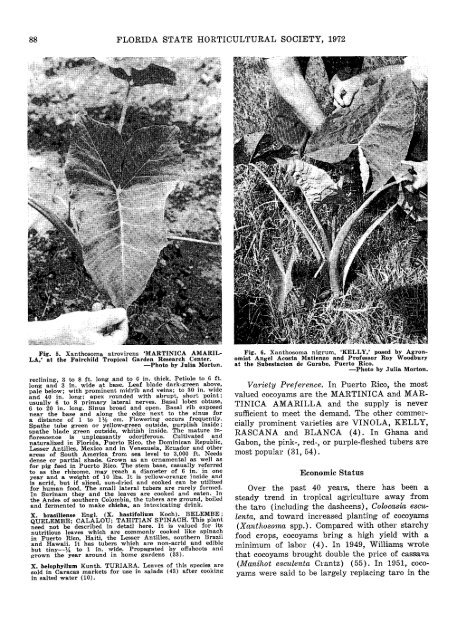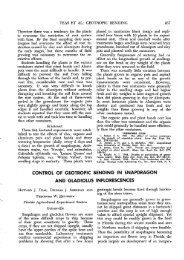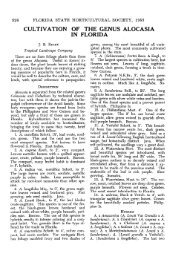(xanthosoma caracu, x. atrovirens and x. nigrum), ancient root
(xanthosoma caracu, x. atrovirens and x. nigrum), ancient root
(xanthosoma caracu, x. atrovirens and x. nigrum), ancient root
Create successful ePaper yourself
Turn your PDF publications into a flip-book with our unique Google optimized e-Paper software.
88 FLORIDA STATE HORTICULTURAL SOCIETY, 1972<br />
Fig. 5. Xanthosoma <strong>atrovirens</strong> 'MARTINICA AMARIL-<br />
LA,' at the Fairchild Tropical Garden Research Center.<br />
—Photo by Julia Morton.<br />
reclining, 3 to 8 ft. long <strong>and</strong> to 6 in. thick. Petiole to 6 ft.<br />
long <strong>and</strong> 3 in. wide at base. Leaf blade dark-green above,<br />
pale below; with prominent midrib <strong>and</strong> veins; to 30 in. wide<br />
<strong>and</strong> 40 in. long; apex rounded with abrupt, short point;<br />
usually 6 to 8 primary lateral nerves. Basal lobes obtuse,<br />
6 to 20 in. long. Sinus broad <strong>and</strong> open. Basal rib exposed<br />
near the base <strong>and</strong> along the edge next to the sinus for<br />
a distance of 1 to \V>> cm. Flowering occurs frequently.<br />
Spathe tube green or yellow-green outside, purplish inside;<br />
spathe blade green outside, whitish inside. The mature in<br />
florescence is unpleasantly odoriferous. Cultivated <strong>and</strong><br />
naturalized in Florida, Puerto Rico, the Dominican Republic,<br />
Lesser Antilles, Mexico <strong>and</strong> in Venezuela, Ecuador <strong>and</strong> other<br />
areas of South America from sea level to 3,000 ft. Needs<br />
dense or partial shade. Grown as an ornamental as well as<br />
for pig feed in Puerto Rico. The stem base, casually referred<br />
to as the rhizome, may reach a diameter of 6 in. in one<br />
year <strong>and</strong> a weight of 10 lbs. It is yellow-orange inside <strong>and</strong><br />
is acrid, but if sliced, sun-dried <strong>and</strong> cooked can be utilized<br />
for human food. The small lateral tubers are rarely formed.<br />
In Surinam they <strong>and</strong> the leaves are cooked <strong>and</strong> eaten. In<br />
the Andes of southern Colombia, the tubers are ground, boiled<br />
<strong>and</strong> fermented to make chicha, an intoxicating drink.<br />
X brasiliense Engl. (X. hastifolium Koch). BELEMBE;<br />
QUELEMBE; CALALOU; TAHITI AN SPINACH. This plant<br />
need not be described in detail here. It is valued for its<br />
nutritious leaves which are commonly cooked like spinach<br />
in Puerto Rico, Haiti, the Lesser Antilles, southern Brazil<br />
<strong>and</strong> Hawaii. It has tubers which are non-acrid <strong>and</strong> edible<br />
but tiny—ii to 1 in. wide. Propagated by offshoots <strong>and</strong><br />
grown the year around in home gardens (33).<br />
X. belophyllum Kunth. TURIARA. Leaves of this species are<br />
sold in Caracas markets for use in salads (43) after cooking<br />
in salted water (10).<br />
Fig. 6. Xanthosoma <strong>nigrum</strong>, 'KELLY/ posed by Agron<br />
omist Angel Acosta Matienzo <strong>and</strong> Professor Roy Woodbury<br />
at the Subestacion de Gurabo, Puerto Rico.<br />
—Photo by Julia Morton.<br />
Variety Preference. In Puerto Rico, the most<br />
valued cocoyams are the MARTINICA <strong>and</strong> MAR<br />
TINICA AMARILLA <strong>and</strong> the supply is never<br />
sufficient to meet the dem<strong>and</strong>. The other commer<br />
cially prominent varieties are VINOLA, KELLY,<br />
RASCANA <strong>and</strong> BLANCA (4). In Ghana <strong>and</strong><br />
Gabon, the pink-, red-, or purple-fleshed tubers are<br />
most popular (31, 54).<br />
Economic Status<br />
Over the past 40 years, there has been a<br />
steady trend in tropical agriculture away from<br />
the taro (including the dasheens), Colocasia escu-<br />
lenta, <strong>and</strong> toward increased planting of cocoyams<br />
(Xanthosoma spp.). Compared with other starchy<br />
food crops, cocoyams bring a high yield with a<br />
minimum of labor (4). In 1949, Williams wrote<br />
that cocoyams brought double the price of cassava<br />
(Manihot esculenta Crantz) (55). In 1951, coco<br />
yams were said to be largely replacing taro in the





